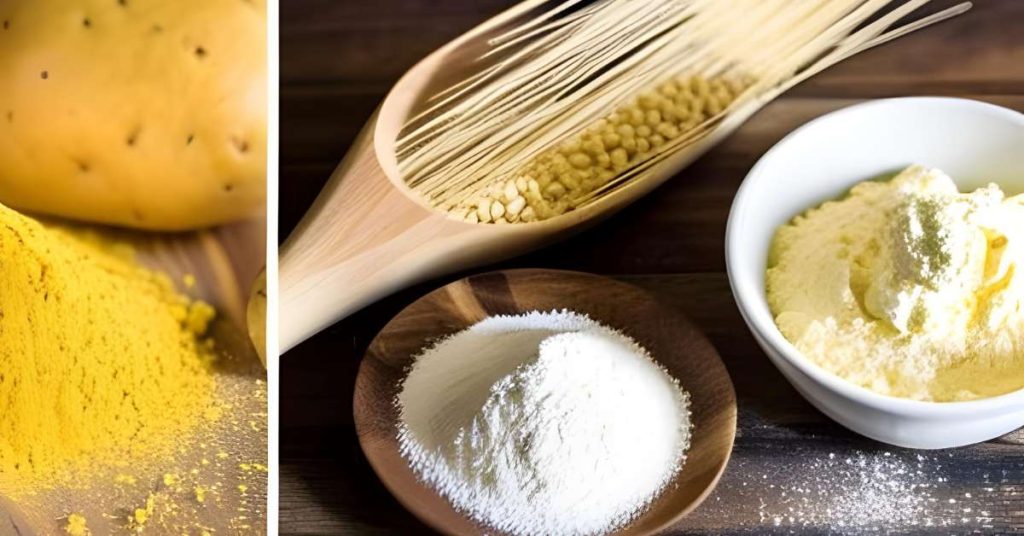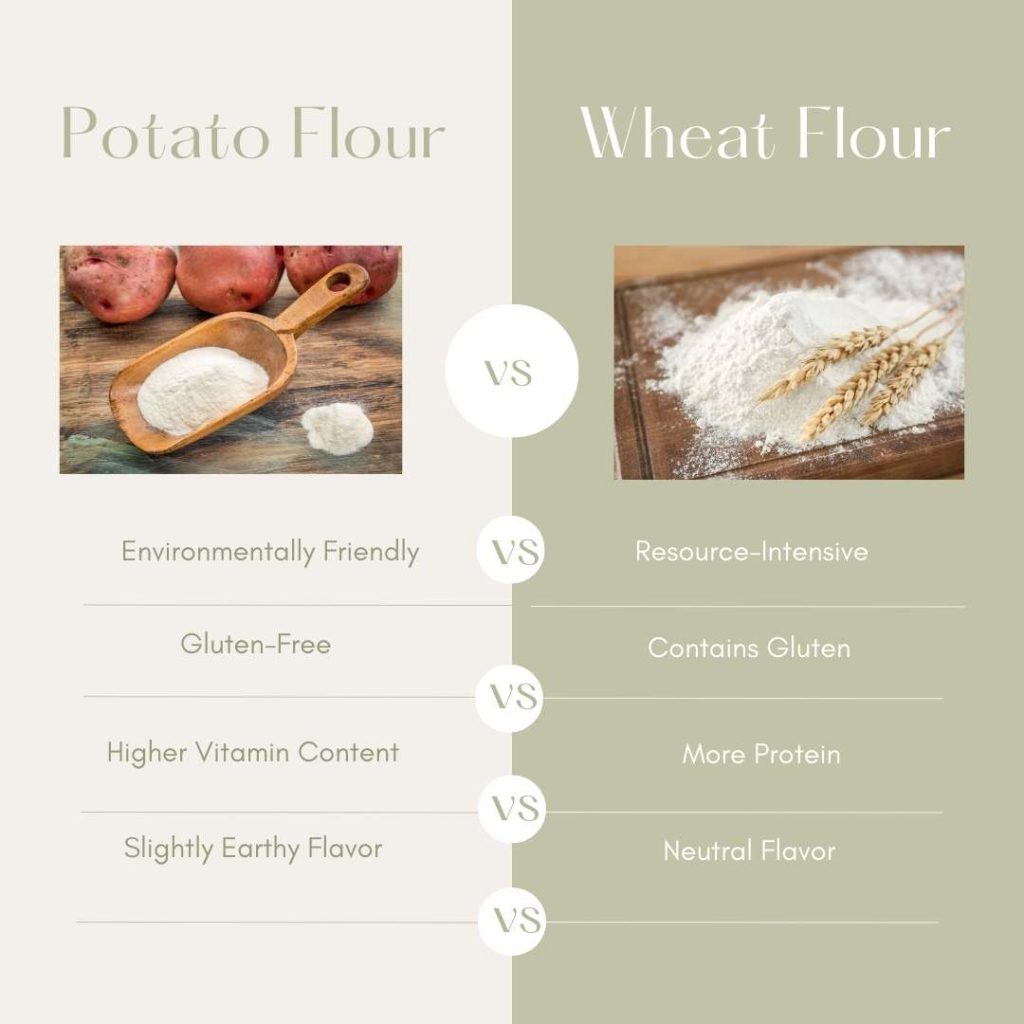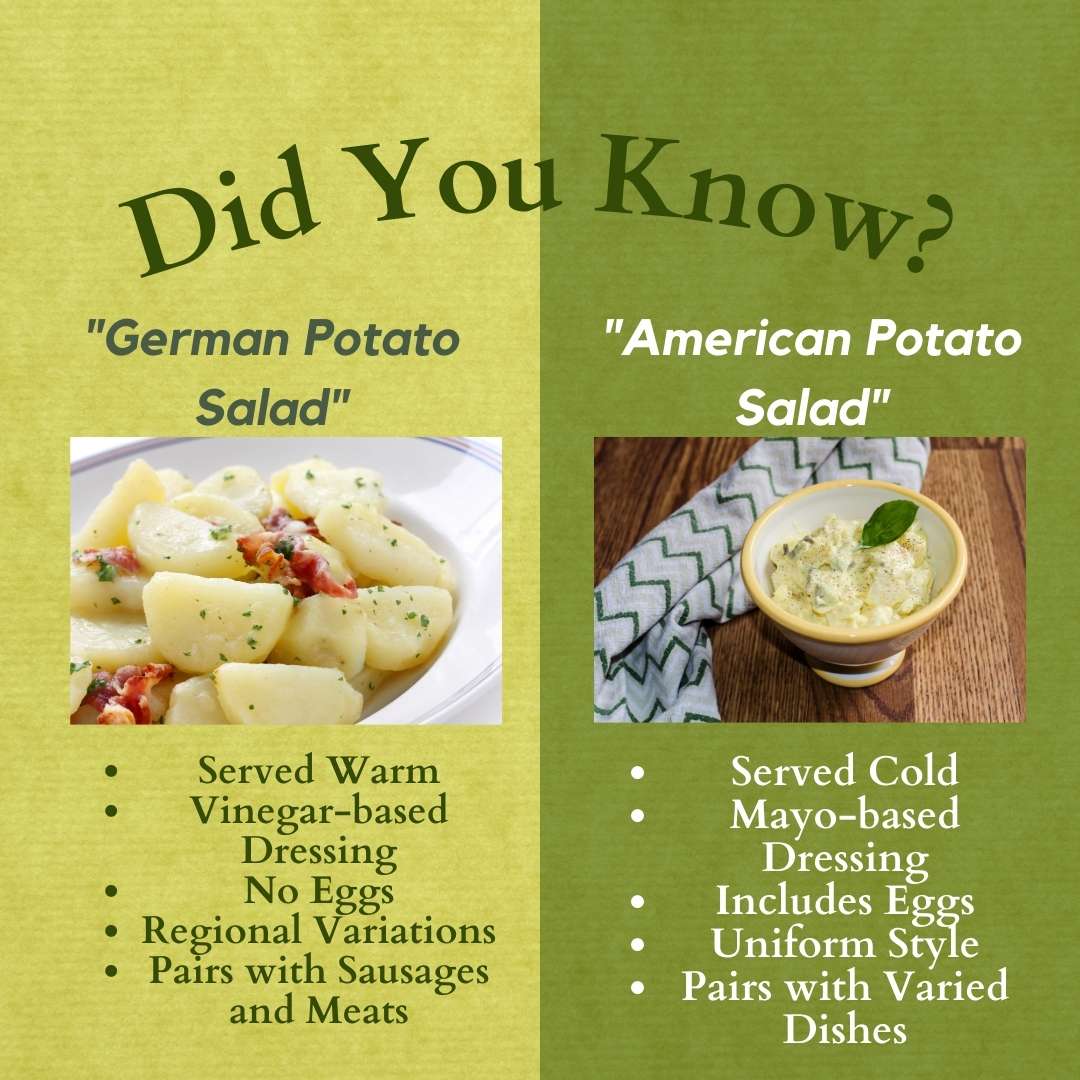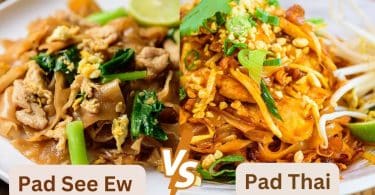Understanding the ongoing debate between potato flour and wheat flour is akin to dissecting the intricate differences in kitchen appliances, such as the Ninja SP101 vs SP201 vs SP301 vs SP351 Air Fry Countertop Ovens or the KitchenAid Hand Mixer Showdown: 7-Speed vs 9-Speed. This guide aims to unravel the layers of complexity in choosing between potato flour and wheat flour for your culinary adventures.
The Basics
What is Potato Flour?
Potato flour is made from whole potatoes, including the skin. They are cleaned, cooked, dried, and then ground into a fine flour. The result is a starchy product with a slight potato flavor. Its unique composition makes it a popular choice in gluten-free cooking and baking.
What is Wheat Flour?
Wheat flour is made from grinding wheat grains into a fine powder. The most common type of flour used in baking, it’s available in several varieties, including whole wheat and white. The gluten content in wheat flour gives elasticity to dough, making it suitable for bread and pastries.
Nutritional Values and Health Benefits
Nutritional Breakdown of Potato Flour
Potato flour contains a good amount of carbohydrates, fiber, vitamins like vitamin C and B6, and minerals such as potassium and magnesium. Its lack of gluten makes it suitable for those with gluten sensitivities.
Nutritional Breakdown of Wheat Flour
Wheat flour, particularly whole wheat, is rich in fiber, protein, vitamins, and minerals. The presence of gluten may cause issues for those with sensitivities, but it’s a nutritious staple for the general population.
Which Flour is Better for Your Health?
The choice between potato flour and wheat flour depends on individual dietary needs and preferences. While potato flour is ideal for those following a gluten-free diet, wheat flour provides more protein and can be a nutritious part of a balanced diet.
Culinary Uses and Sensory Properties
Culinary Uses
Baking with Potato Flour: Tips and Tricks
Potato flour is an extraordinary ingredient for gluten-free baking. It can be used to create everything from bread to cookies, and even pancakes. The key to success with potato flour is understanding its properties. Unlike wheat flour, it doesn’t contain gluten, so it doesn’t have the same elasticity. This means that recipes may need adjustments, such as adding xanthan gum to provide structure. Additionally, potato flour tends to absorb more liquid, so a little goes a long way.
Here are some common applications:
- Bread: Potato flour adds moisture, creating a tender crumb.
- Cookies: Provides a delightful chewiness when used in small amounts.
- Pancakes: Creates fluffy, moist pancakes with a slight potato flavor.
Baking with Wheat Flour: Traditional Techniques
Wheat flour is the go-to option for most traditional baking recipes. Its gluten content gives structure to bread, cakes, and pastries. Here’s how it’s commonly used:
- Bread: The elasticity of wheat flour creates a chewy, satisfying texture.
- Cakes: Depending on the type of wheat flour, it can produce light or dense cakes.
- Pastries: Perfect for flaky crusts and delicate pastries.
Cooking Beyond Baking: Savory Dishes Explored
Both potato and wheat flour can be used in savory cooking. Potato flour is excellent for thickening soups, stews, and sauces, while wheat flour is a common ingredient in roux and coatings for fried foods.
Sensory Properties
Taste and Texture of Potato Flour
Potato flour has a unique taste that’s slightly earthy, with a hint of potato flavor. Its texture can be somewhat grainy if not well incorporated. In baked goods, it provides moisture and softness.
Taste and Texture of Wheat Flour
Wheat flour has a neutral flavor that can vary depending on the type (e.g., whole wheat has a more robust flavor). Its texture is smooth, and it provides structure to baked goods. The elasticity from the gluten content makes it versatile across many culinary applications.
Dietary Considerations, Environmental, and Economic Considerations
Dietary Considerations
Potato Flour in Gluten-Free Diets
For those with celiac disease or gluten sensitivity, potato flour offers a valuable alternative. It can be used in a wide range of recipes without triggering gluten-related reactions. In addition to being gluten-free, potato flour is also suitable for vegan and vegetarian diets. Its ability to retain moisture makes it an attractive option in baking, creating moist and flavorful dishes.
Wheat Flour in Various Dietary Plans
Wheat flour, while not suitable for gluten-free diets, is a rich source of nutrients that fits well into balanced eating plans. Whole wheat flour, containing all parts of the grain, offers additional fiber and vitamins. For those following a Mediterranean or plant-based diet, whole wheat flour can be a nutritious staple. However, refined wheat flour may be less desirable for those watching their glycemic index or attempting to minimize processed foods.
Environmental and Economic Considerations
Sustainability of Potato Flour
Potato flour production can be considered more environmentally friendly than wheat, especially if locally sourced. Potatoes require less water and are adaptable to various soil types. Additionally, potato flour can be made from imperfect potatoes that might otherwise be discarded, minimizing waste.
Sustainability of Wheat Flour
Wheat farming can be more resource-intensive, requiring ample water and fertile soil. However, advancements in sustainable farming techniques, such as crop rotation and reduced pesticide use, are addressing these concerns. Local, organic wheat flour may also present a more sustainable choice.
Economic Factors
The cost of both potato and wheat flour can vary based on factors like brand, organic status, and location. Generally, potato flour may be more expensive due to specialized production and lower demand. Wheat flour, being a staple in many households, is typically more affordable and readily available.
Conclusion
Wrapping Up the Great Debate: Potato Flour vs Wheat Flour
The journey through the world of flours is as intricate and layered as the culinary masterpieces they help create. Both potato and wheat flour hold a distinctive place in the kitchen, each with unique attributes, applications, and considerations.
What’s Best for You? A Personalized Look at Potato and Wheat Flour
- For the Gluten-Free Consumer: Potato flour stands out as a remarkable choice. Its absence of gluten and unique textural properties allow it to be a versatile ingredient in gluten-free recipes.
- For the Traditional Baker: Wheat flour remains an unparalleled classic. From bread to pastries, its protein content and elasticity make it an indispensable asset.
- For the Health-Conscious Individual: Both flours can fit into a healthy diet. While potato flour offers a higher vitamin content, whole wheat flour provides fiber and essential nutrients.
- For the Environmental Advocate: The sustainability of both flours presents unique considerations. Potato flour may have an edge in water efficiency, while sustainable farming practices are enhancing wheat flour’s ecological footprint.
- For the Budget-Savvy Shopper: Wheat flour often comes at a lower price point, while potato flour might be considered a specialty item, commanding a higher cost.
The Final Flourish
Choosing between potato flour and wheat flour is more than a mere culinary decision; it’s an alignment with personal preferences, dietary needs, and even values. Like the careful selection of kitchen gadgets, such as the Ninja SP101 vs SP201 vs SP301 vs SP351 Air Fry Countertop Ovens or the KitchenAid Hand Mixer Showdown: 7-Speed vs 9-Speed, the right flour can elevate your culinary experience to new heights.








